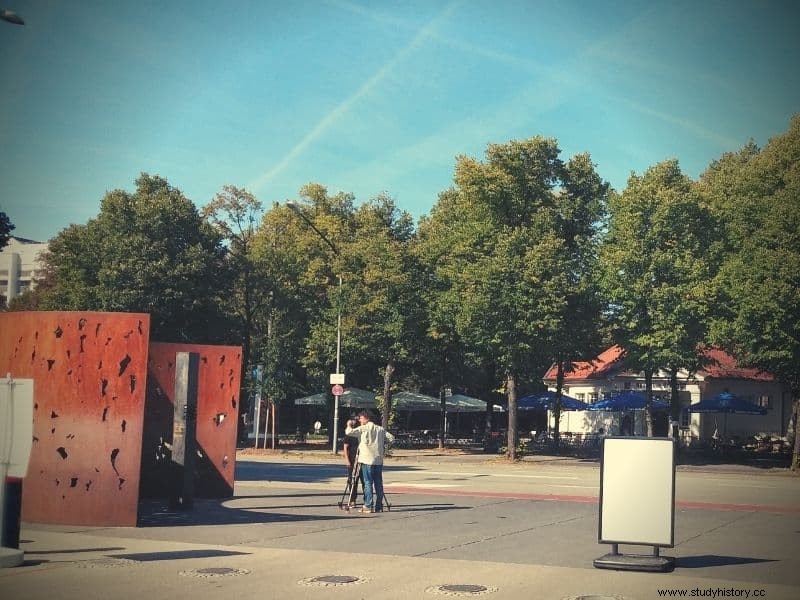
As is well known, the Oktoberfest will not take place this year due to the corona pandemic. 2020 is the first year since the end of the Second World War that the festival had to be cancelled. But that doesn't mean that there hadn't been drastic moments earlier when the Wiesn was close to being closed. One such moment is celebrating its 40th anniversary this year:the Oktoberfest attack in 1980. A good reason to take a closer look at this event. What happened back then, why are the investigations still controversial today and what does that tell us about the right-wing problem in Germany today? Spoilers:Unfortunately, a frightening amount.
Terror in Germany until 1980
The Oktoberfest attack of 1980 was supposed to be the most serious terrorist attack in German history. With the best will in the world, terror was not unknown in Germany and also in Munich at the time. The 1970s were a violent time throughout the Federal Republic. In 1972, for example, there was a terrorist attack on the Israeli team during the Olympic Games in Munich. Throughout the decade, there were murders and attacks by the RAF nationwide. Around 1980, this meant two things:First, political terror was a well-known danger in the Federal Republic of Germany at the time. Second, this danger was seen almost exclusively in left-wing extremist circles. We should keep that in mind when we look at the events surrounding the Oktoberfest attack in Munich.
It was September 26, 1980, a Friday. As usual, the Oktoberfest was well attended and everything was as usual – until just after 10 p.m. A bomb exploded in a wastepaper basket at the main entrance to the Wiesn, killing thirteen people in the immediate vicinity. Within a radius of tens of meters, she injured hundreds of other passers-by, some seriously. There had never been an attack of this type and scale in Germany. The time was a critical one and pointed to a political background from the start:federal elections were held on October 5th. The Bavarian Minister-President Franz Josef Strauss ran against Helmut Schmidt as the CSU/CDU candidate for chancellor. Part of Strauss' platform was the fight against left-wing terror. The political reactions to the Oktoberfest attack should be seen in this context.
Who was behind the Oktoberfest attack?
These reactions were initially cautious. The Oktoberfest was only closed for one day and Strauss soon blamed the federal government for the tragedy in order to distance himself and his election campaign from the assassination. At the same time, a special commission of the Bavarian police began to investigate the attack. It didn't take long before she was able to present a suspect:one of the thirteen victims of the explosion, a young man named Gundolf Köhler, is said to have detonated the bomb. The man was known to the police. In the years before he had been active in the circle of the right-wing extremist "Wehrsportgruppe Hoffmann". This group around the Franconian neo-Nazi Karl-Heinz Hoffmann had been training guerrilla tactics in preparation for a German civil war since the mid-1970s and was only banned as anti-constitutional in the spring of 1980. So the culprit seemed credible.
This is where the open questions in the investigation begin. Although indications of complicity by other former members of the Wehrsportgruppe were investigated, the investigators came to the conclusion that their involvement in the Oktoberfest attack could be ruled out. Gundolf Köhler is said to have been a lone perpetrator. A conclusion that has repeatedly given rise to criticism ever since. As early as the investigations in 1980, there were concrete indications of other perpetrators. Two witnesses claim to have seen Köhler arguing with two other men at the Oktoberfest entrance about half an hour before the explosion. As a result, both witness statements were not followed up any further. Investigations into the right-wing extremist scene in Germany did not reveal any new connections for the investigators, although two members of the scene had first contacted the investigators. At the end of 1982 the investigations were filed. Officially, Gundolf Köhler was the sole perpetrator.
The BR journalist Ulrich Chaussy and new investigations
But some were not satisfied with that. In the decades that followed, the most well-known critic of the investigation into the Oktoberfest attack was the BR journalist Ulrich Chaussy, who investigated the indications of other perpetrators. A key discrepancy involved a severed hand that was found at the crime scene but could not be matched to any of the dead. It could have come from a second assassin who survived and escaped. And indeed, Chaussy was able to gather some evidence for this, even if he found no concrete proof. Also due to Chaussy's investigations, the investigations into the Oktoberfest attack were then rolled out again in 2014. New witnesses were heard, but the investigators did not come to any new conclusions this time either. The investigations were discontinued in July 2020.
We will probably never be able to definitively clarify whether there were actually other backers behind the Oktoberfest attack. It is also questionable how much has been learned from this. Almost ten years after the attack in Munich, a new wave of right-wing violence broke out across Germany, especially against asylum seeker homes. The NSU murders followed, and most recently the attacks in Halle and Hanau, among many others. The impression that the right eye of the judiciary is still weak does not really want to go away. More and more information about the spread of right-wing extremist views in parts of the police force does the rest. Forty years of the Oktoberfest attack should therefore still give us food for thought in 2020. We don't seem to have gotten very far in this country since then.
